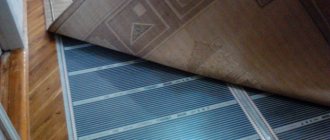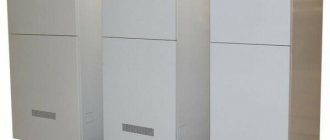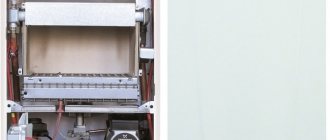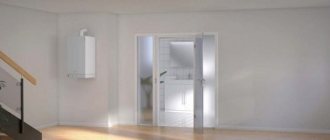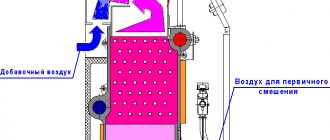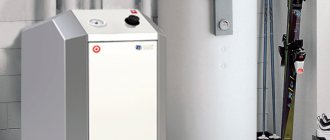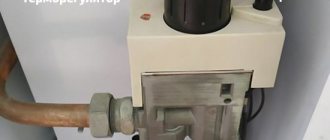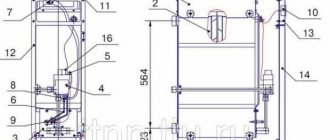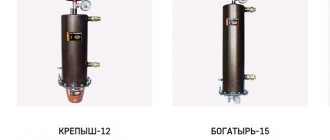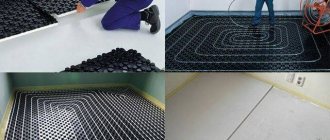Specifications
The coolant “Warm House ECO-30” has high stability and guarantees constant operation for five years. In order to obtain the mixture at the desired temperature, it should be diluted with ordinary tap or distilled water. If you add 10% liquid, the start temperature of the crystallization process will be equal to -25 °C, but when the volume increases to 20%, the temperature rises to -20 °C.
The system cannot be destroyed, because the described antifreeze does not increase in volume when frozen, but only becomes jelly-like. The coolant “Warm House EKO-30” can be diluted with water, this allows to reduce its viscosity and increase heat capacity, as well as improve circulation.
The optimal solution is to dilute the product to a crystallization level of -25 °C; this is true for electric boiler equipment. If we are talking about gas boilers, then this parameter should be -20 °C. Using a composition that has a lower crystallization temperature in operation can cause glycol carbon deposits on the heating elements or in the burner area, which will lead to the formation of tarry deposits and a situation where the heating elements simply burn out.
How to properly dilute antifreeze for a heating system?
When pouring Dixis-65 concentrate, or another composition in the form of a concentrate, mix it with water only in a separate container. And only after that, fill the system with the already prepared, uniform mixture. Mixing antifreeze with water inside the system can unexpectedly make it difficult for the system to function properly. The result of improper mixing: - uneven heating of heating devices, and some devices do not heat at all due to the separation of water and antifreeze; — malfunctions of the circulation pump and even its failure; — foaming inside the system leads to its forced complete emptying, repeated flushing and refilling; - IN NO EVENT DO YOU STIR DIXIS-30, and especially DIXIS TOP, that are ALREADY READY for pouring. In this case, the foam will clog the system so much that it will be difficult to even rinse it again. When using expensive equipment, such things are generally unacceptable! If it’s already late and you poured liquid first and then water, DO NOT TURN THE CIRCULATION PUMP ON AT MAXIMUM speed (so that it mixes faster). Let everything remain as it is. Be patient. Periodically open the air vents on radiators. It takes time for everything to come together. In the case of gravitational systems (gravity flow), things are more complicated, and mixing takes much more time. That is why in almost all gravity systems we install a circulation pump through the bypass. Be patient and wait until it mixes. Dixis-65 concentrate is much cheaper in diluted form than Dixis-30 and even more so DIXIS TOP. But in practice, if your specialist has little experience, use only ready-made solutions offered by the manufacturer or contact us.
Antifreeze "DIXIS-65" is widely used in various systems - cooling, heating and air conditioning - not only in industrial but also in residential premises. The priority purpose of this antifreeze is to protect the system from so-called “defrosting” in low temperature conditions. In addition, DIXIS-65 antifreeze copes very well with the function of protecting equipment from corrosion processes and the onset of scale formation. A distinctive feature of DIXIS-65 antifreeze is the ability to use it both in its original and in a diluted state. In its original form, this coolant can be used in low-temperature climatic regions, for example, regions of the Far North. In a diluted state, DIXIS-65 can be used in regions with a temperate climate, where temperatures are not so low. By diluting this antifreeze with water in a ratio of 5:1, we obtain a coolant with a crystallization onset temperature of minus 40°C. Ratios of 2:1 and 1:1 make it possible to obtain antifreeze with an onset of crystallization equal to minus 30°C and minus 20°C, respectively. Antifreeze "DIXIS-65" is a homogeneous transparent liquid with a yellow-greenish color without mechanical impurities.
How to avoid decomposition
The coolant “Warm House EKO-30” can be used for a period of time, which will depend on operating conditions. The product should not be brought to such a temperature that it boils, because when the temperature increases to 170 ° C, thermal decomposition of additives and propylene glycol begins to occur. Therefore, good circulation of the described substance should be ensured in boilers.
Consumer Reviews
If you decide to use the “Warm House ECO-30” coolant for the heating system of your home, reviews about it will be able to help you understand its features. Thus, consumers claim that to avoid unpleasant situations, the coolant should be diluted, as recommended above. It is important to supplement the system with a good circulation pump unit, which has more outstanding characteristics compared to those devices that operate on water.
As for performance, according to consumers, this parameter should be 10% higher, while the pressure should be 60% higher. At subzero temperatures, the coolant, according to buyers, should heat up gradually, and the equipment should not be turned on at full power immediately.
According to experts, the coolant “Warm House ECO-30” (20 kg) has a more impressive expansion coefficient when compared with water, which indicates the need to maintain the volume of the expansion tank. This parameter is 15% of the coolant volume or more.
Buyers also like the fact that the products described are completely safe for human and animal health. The composition is approved for use as a refrigerant in the food industry. However, this does not mean that the product can be eaten!
The evaporation of such a coolant is completely safe for health. Buyers especially emphasize that the coolant “Warm House EKO-30”, the characteristics of which are presented in the article, is explosion- and fireproof, it has a certificate of conformity and conclusions of sanitary and epidemiological services.
After 5 years of operation, this substance becomes a low-freezing liquid, however, the life of the additives will be exhausted, as will the ability to resist corrosion. That is why the coolant “Warm House ECO-30”, the operating instructions for which will be presented in the article, must be drained and disposed of. Before filling in new coolant, it is important to check all connections and flush the system.
Instructions for use
The coolant “Warm House ECO-30” (20 kg) must be poured into a system with galvanized pipes, since their internal walls can cause precipitation. It should not be used in systems with electrolysis boilers and should not be mixed with other coolants without first checking what consequences this may lead to. The simplest outcome in this case will be a deterioration in the performance characteristics of the composition.
The coolant is intended only for technical use, because ethylene glycol is a toxic substance when taken orally. In order to prevent poisoning, it is important to be sure that the product does not get into food or water. If the composition comes into contact with the skin, it should be washed thoroughly with soap and water.
About the concentrated coolant Teply Dom 65
Concentrated heating fluid Teply Dom 65
It is made from high-quality ethylene glycol and is intended for use as an antifreeze liquid (antifreeze) in various heating and cooling systems (industrial air conditioning) in the operating temperature range from -65°C to 112°C.
A special package of additives, consisting of 10 (ten) inhibitor component substances, used in the Teply Dom 65 , is designed to impart anti-corrosion, anti-foaming and anti-foaming properties to the coolant, as well as to stabilize the thermophysical properties over the entire operating temperature range.
Concentrated coolant "Teply Dom 65"
» is produced using a combined package of anti-corrosion, anti-scale and anti-foam additives and is intended for the production of heating coolants
- aqueous solutions with a lower crystallization (freezing) temperature. Dilution with water allows you to increase the heat capacity and thermal conductivity of the solution, as well as significantly reduce the viscosity, thereby improving the circulation of the coolant in the system and significantly increasing the heat transfer of the system. The best thermophysical characteristics are exhibited by coolants manufactured (diluted) at crystallization temperatures of -25°C
and
-30°C
.
And for gas and electric double-circuit boilers - to minus - 20°C
.
Heating coolants with such thermophysical characteristics are guaranteed to protect the system from destruction in the event of an emergency shutdown, even at lower temperatures in the working premises and in the system itself, since ethylene glycol solutions crystallize into a jelly-like form.
It should be noted that the use of coolants with a high concentration of ethylene glycol is more likely to lead to carbon deposits on the heating elements or in the burner area and the formation of tarry deposits, and burnout of electric heating elements (heating elements). As a result, heat transfer decreases due to the deterioration of the thermophysical characteristics of the coolant itself and the thermal conductivity and heat transfer of the system itself.
To obtain an aqueous solution with the required operating temperature (the temperature at which crystallization begins, freezing), the coolant Teply Dom 65 should be diluted with distilled water or tap water with a total hardness of no more than 6 mEq/l in accordance with the table below:
Recipe-calculation for obtaining 100 liters of ready-made solution from concentrated coolant "Teply Dom 65"
:
| Coolant "Teply Dom 65", l | Water, l | Temperature of the beginning of freezing (crystallization), t°C |
| 77 liters | 23 liters | -40ºС |
| 65 liters | 35 liters | -30ºС |
| 60 liters | 40 liters | -25ºС |
| 54 liters | 46 liters | -20ºС |
To obtain any other amount of aqueous solution (according to the selected crystallization temperature and the corresponding values in the line!!!)
The values of coolant and water given in the table, in liters, are proportionally increased or decreased by the coefficient
K = V/100
, where V is the volume of the coolant solution being prepared, for example, if the volume
V
= 56 liters, then coefficient
K
= 0.56;
if the volume V
= 1559 liters, then the coefficient
K
= 15.59.
If water from wells, wells, etc., where there may be a high content of salts and metals, is used to dilute the coolant, then it is recommended to first mix a small volume of the Teply Dom 65 coolant with water in the required proportion in a transparent container and make sure there is no sediment. Mixing the coolant with water can be done immediately before pouring into the system (especially for systems with natural circulation) or by filling it alternately in small portions.
Coolants “Teply Dom 65”, thanks to complex additives, have high stability of thermophysical properties and ensure continuous operation for 5 years. After five years of operation, the coolant will remain a low-freezing liquid, but the resource of additives to counteract corrosion and scale will be exhausted. Therefore, the coolant must be drained and disposed of. Before filling in new coolant, the system must be flushed with a special liquid or water.
It should be borne in mind that the service life of the coolant depends on its operating conditions. Not recommended:
- pour coolants into systems with galvanized pipes, as galvanizing may peel off and precipitation may occur;
- use coolants in heating systems with electrolysis boilers of the “Galan” type;
- mix Warm House coolants with other coolants, as this will definitely lead to a deterioration in the performance properties of the coolant, and as a result, possible damage to equipment;
- bring coolants to a boiling state during operation, as this leads to decomposition of additives and ethylene glycol and deterioration of the thermophysical properties of the coolant with a decrease in the service life of the solution.
Coolant Teply Dom 65
intended for technical use only (ethylene glycol is toxic). To avoid poisoning, do not allow it to get into food or drinking water. If it gets on clothing or exposed parts of the body, it can be easily washed off with soap and water.
Teply Dom coolants are fire- and explosion-proof, have certificates of conformity and sanitary-epidemiological conclusions, have been tested at the Plumbing Research Institute and are approved for wide use.
Coolants should be stored out of the reach of children, in sealed containers, away from food products, and away from direct sunlight.
We are interested in mutually beneficial cooperation.
Additional recommendations for use
If you decide to dilute the coolant with water from a well or well, where a high content of metals and salts may be noted, you should mix the product with water in a transparent container. It is important to maintain the required proportion. Once you are sure that there is no sediment, you can mix in the required volumes to fill the heating system.
This can be done before pouring the product into the system, which is especially true for systems that operate on the principle of natural circulation. As an alternative solution, a technology is sometimes used in which the filling occurs alternately, while the coolant can be prepared in separate small portions.
How and with what to dilute the coolant for the heating system?
Many manufacturers sell concentrated glycol-based coolants.
They categorically cannot be poured into the system in their pure form, otherwise you will encounter serious problems, the solution of which will take time and additional funds. Negligent attitude towards expensive equipment leads to almost irreparable consequences. For this reason, we do not recommend doing it on your own. It is better to first consult with the manufacturer and strictly follow the existing instructions. Today we will answer the question “how to dilute the coolant for the heating system https://www.eglikol.ru/hot-stream-teplonositel-dlya-sistem-otopleniya” and give advice on how to do it correctly. Preparing coolant for filling from concentrate
Household antifreeze must be diluted with distilled water, and always before pouring it into the system, in a specially prepared container. Regular tap water contains many unnecessary impurities that will impair the performance of energy systems. Distilled water is completely purified and helps extend the service life of the coolant.
If you decide to mix concentrate with water in the system itself, you will encounter the following problems:
• uneven heating of the equipment; in some parts it may not produce heat at all, since antifreeze and water are located in different places; • failures in the functioning of the circulation pump, and sometimes it stops altogether; • foaming, to get rid of it, you will need to remove antifreeze from the system and refill it.
To prevent this from happening, dilute the antifreeze in advance and fill in the already diluted one.
The coolant, ready for use in equipment, does not need to be diluted. This will change its properties. As a result, it will not be able to function properly and fulfill its intended purpose.
Before adding new antifreeze, be sure to pre-flush the system and boiler. Only after this can the coolant be changed.
What do you need to know before choosing a coolant?
• The decision about which coolant to use is made at the equipment design stage. Antifreeze and water require different supply systems.
• Pay attention to the various characteristics of the substance: its composition, additional additives, safety, shelf life and others. It is important to compare this with your terms of use.
• Carefully read the instructions for use, otherwise you may encounter serious problems (incorrect filling, harm to human health, damage to equipment).
The concentration of water in antifreeze determines what temperature conditions it will withstand, so before diluting the coolant, consult with the manufacturer.
